Description: The Carpet anemone, also known as Merten’s carpet anemone, is named for its large size, which resembles a carpet. The short tentacles give it the appearance of a piece of shag or plush carpet. It has an ovoid (egg-shaped) oral disc that is cream, yellow or green in color with white, yellow or green-tipped tentacles. The whitish-tan pedal column has magenta to orange colored wart-like adhesive bumps (verrucae) under the edge of the oral disc, which hold the disc in place. Like other sea anemones, the Carpet anemone has stinging nematocysts stingers in its tentacles.
Size: Merten’s carpet anemone is regarded as the largest sea anemone with a diameter of over three feet (one m).
Behavior: This sea anemone can host more than a dozen different clownfish species that hide within the tentacles without being stung.
Diet: Carpet anemones have a relationship with symbiotic single-celled algae called zooxanthellae. The algae undergo photosynthesis to produce food from sunlight and this food is shared with the sea anemone. In return, the Carpet anemone provides shelter and minerals for the algae. These carnivores are opportunistic feeders. In addition to the zooxanthellae, they can use their stinging nematocysts to capture prey such as small fish, crabs, shrimp and snails that get too close.
Senses: They are ‘touch’ sensitive. The slightest touch against the tentacles results in the ‘firing’ of sharp stinging filaments into the victim.
Reproduction: Anemones can reproduce sexually and asexually. Some are hermaphrodites capable of producing both sperm and eggs. Others divide into parts, with new animals growing from each part – clones.
Habitat/range: They are found on rocky or coral substrate in the Indo-Pacific region.
Status: This anemone has not been assessed for the IUCN Red List.



